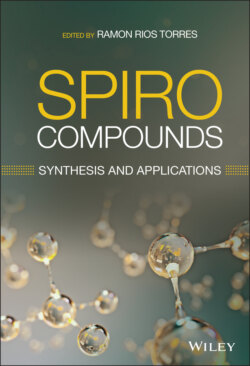Читать книгу Spiro Compounds - Группа авторов - Страница 14
2.2 General Features
ОглавлениеThe sp3‐rich character of spirocycles and resulting extended range of exit vectors spanning across all three spatial dimensions represent an exciting opportunity for expanding molecular complexity while maintaining structural rigidity. These two parameters are also of prime importance for optimizing the thermodynamic fingerprint of chemical probes and drugs, and achieve optimal potency and selectivity profiles. At the same time, structural novelty opens valuable avenues for exploring new chemical spaces and IP protection of novel bioactive scaffolds. Spirocycles give access to more rigid scaffolds and better‐defined directionality of exit vectors, particularly for spirocycles containing small rings (e.g. cyclobutanes, oxetanes, azetidines, and thietanes, Figures 2.2 and 2.3), which are conformationally highly restricted. Studies by Lovering showed a positive correlation between the simple indicator of saturation Fsp3 = (number of sp3 hybridized carbons/total carbon count) and the number of stereogenic centers as compounds progress through clinical trials, suggesting an enrichment in these features along clinical development [26]. Another direct consequence of their sp3 richness is their higher density of exit vectors (D ev, Figure 2.2) compared with sp2‐rich systems. D ev can be a useful primary indicator to rapidly estimate the three‐dimensionality of a scaffold and its potential for molecular complexity and diversity generation through synthesis. We use this indicator regularly in our lab as a criterion to prioritize fragment hit‐to‐lead optimization. This contrasts with some scaffolds that have been at the center of drug discovery over the last decades. Those include the typical poly(hetero)aromatic structures which result from linking of multiple two‐dimensional units, and provide limited scope for targeting the three dimensions. As a result, the 3D character of spirocycles and greatly extended range of accessible vectorizations are regarded as powerful ways to “escape from flatland” [26, 27] through the bioisosteric replacement of “flat”, sp2‐rich scaffolds found in historical fragment and lead screening libraries.
Figure 2.2 Schematic comparison of substituted biaryl and spiro[3,4]octane scaffolds: the overall conservation of the relative orientation and high density of exit vectors can be exploited for bioisosteric replacement strategies.
Figure 2.3 Examples of saturated spirocyclic ring systems frequently encountered in drug discovery.
The constrained and directional exit vectors projected from “spiro” scaffolds allow fine‐tuning the relative orientations of functional groups within bioactive molecules in order to achieve optimal molecular interaction with a target receptor. Such rigidity can also be exploited for the bioisosteric replacement and conformational restriction of flexible moieties in biomolecules, hence reducing detrimental entropic penalties for binding [28]. Spirocycles have also been used to modulate physicochemical properties and pharmacokinetics of biomolecules, including aqueous solubility and metabolic stability [26, 27, 29]. A number of reports have also highlighted that a high sp2/aromatic content is generally detrimental to the physicochemical properties of drug candidates [26, 27, 30, 31].
